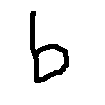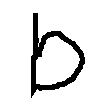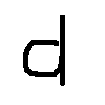Instructions
This HIT consists of many subtasks, and you must complete every subtask to submit the form. You should expect this HIT to take approximately 15-30 minutes.
This task tests your ability to discriminate handwritten
characters from writing systems around the world. For example in
the Latin alphabet A, B, C, and D are different characters. In
each subtask, you will see pairs of character images, and no two
images are exactly the same. Importantly, your task is
not to judge whether the two images are literally the same,
but rather whether they are images of the same type of
character (for example,  and
and  ) or instead of two different types of characters (for
example,
) or instead of two different types of characters (for
example,  and
and  ).
).
Part I: Calibration
Here you will see a sequence of 25 subtasks that test how quickly you can press a key. Each subtask has the following structure:
- Five pound signs (#####) are shown on the screen.
- After a short pause, two pound signs are replaced by letters (#B#D#).
- After the letters appear (#B#D#), press a key (such as the 'a' key) as quickly as you can.
Part II: Character Discrimination
Here you will see a sequence of 210 subtasks. Each subtask has the following structure:
- Five images of random scribbles are shown on the screen.
- After a short pause, two of the scribbles will be replaced by images of characters.
-
If the images are of different types of
characters (for example,
 and
and  ),
press a key (for example, the 'a' key)
as quickly as you can. If the images are
of the same type of character (for example,
),
press a key (for example, the 'a' key)
as quickly as you can. If the images are
of the same type of character (for example,
 and
and  , do not press any key and wait for the
next trial.
, do not press any key and wait for the
next trial.
The characters you will see should be new to you, so make your best guess. After every few characters, a progress bar appears to show you your accuracy so far. You may take a break from the task at this time.
Please note:
-
You must complete every subtask to submit the form. (The
question(s) at the end, however, are optional.)
- If you somehow manage to submit the form without completing every subtask, your submission will be rejected.
- So long as you complete every subtask, and you make an effort to answer the questions correctly, your submission will be accepted regardless of how many you get correct.
Disclaimer
By answering the following questions, you are participating in a study being performed by cognitive scientists in the MIT Department of Brain and Cognitive Science. If you have questions about this research, please contact Josh Tenenbaum at jbt AT mit DOT edu. Your participation in this research is voluntary. You may decline to answer any or all of the following questions by clicking the 'Return HIT' button at the top of this page. by clicking the 'Back' button at the top of your browser. (Alternatively, you may click here.) You may decline further participation, at any time, without adverse consequences. Your anonymity is assured; the researchers who have requested your participation will not receive any personal information about you.
If you are interested in learning more about this research, please visit //jgross.scripts.mit.edu/alphabets/ (this link will open in a new window or tab, so you do not need to worry about losing your submisison).